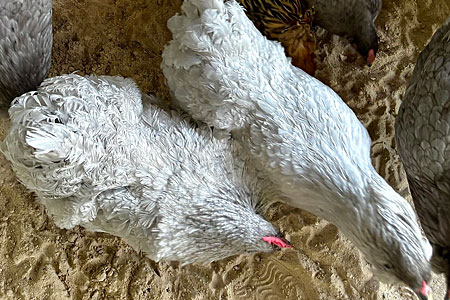
“The shredder gene in lavender chickens causes the feathers to split and the barbs to detach, resulting in rough looking feather development,” explains Jeff Smith of Cackle Hatchery®. Lavender, also known as self blue, is a plumage color resulting from an autosomal recessive gene. Let’s explore how it works.
Lavender vs. Blue
The lavender gene is autosomal, meaning it is not on the sex chromosome. Therefore the gene is the same in both male and female chickens.
The gene is recessive, therefore it must come from both parents in order for chicks to appear lavender. Mating two lavender chickens results in 100% lavender chicks.
Lavender plumage is an even shade of light slate blue, called self blue. The term “self” refers to the fact that the feathers are all entirely one color.
“Blue is a similar color to lavender, but differs genetically,” Jeff says.
Rather than being recessive, like lavender, blue is an incompletely dominant gene and therefore results from a combination of two alleles (variations of the same gene). Blue chickens do not breed true. Mate a blue to a blue and you will get only 50% blue chicks. Half of the remaining chicks will be black and the other half will be splash.
To get 100% blue chickens, you would need to cross black with splash. And, unlike lavender chickens, blue chickens are not all the same shade of blue.
Shredder Gene
Lavender chickens were created from black chickens. The lavender gene (lav) is recessive to the black gene (lav) and dilutes the color black to a pale slate blue.
Unfortunately, the lavender gene is associated with a recessive shredder gene, sometimes called the tail shredder gene. “We have this issue in our lavender Ameraucanas and our lavender Orpingtons.” says Jeff. “To improve feather quality, we breed black into lavender to create splits.”
A split is a chicken that appears black but has a lavender gene. A black split rooster bred back to lavender hens will result in 50% lavender chicks with improved feather quality.
Genetically Speaking
Breeding lavender to lavender yields 100% lavender chicks (homozygous). In other words, a chicken with lavender plumage is 100% lavender.
Crossing black with lavender yields 100% splits (heterozygous black chickens carrying the recessive lavender gene).
Crossing split to lavender yields 50% splits and 50% lavenders with a suppressed shredder gene.
Breeding split to split yields 25% lavenders and 75% black colored chickens (50% splits, 25% blacks). At this point you have no way of knowing which chickens are true blacks and which are splits carrying the lavender gene, unless you get a DNA test for lavender.
Breeding black to split yields all black colored chickens, of which 50% are homozygous blacks and 50% are splits. So you have no lavender offspring and, again, no way other than DNA testing to determine which black colored chickens are carrying the lavender gene.
As Jeff suggests, then, the practical way to suppress the shredder gene in lavender chickens is to produce splits by breeding black to lavender. Then breed the splits back to lavender, and selectively breed the best feathered of the resulting lavender chickens.
And that’s today’s news from the Cackle Coop.
Gail Damerow is the author of Storey’s Guide to Raising Chickens.


I have 3 Lavender Orphingtons form your hatchery that were hatched April 17th. Two of the 3 appear to have the shredder gene.